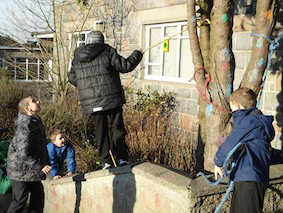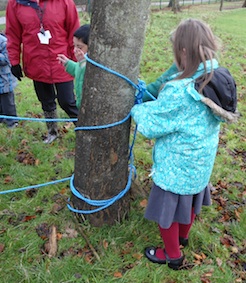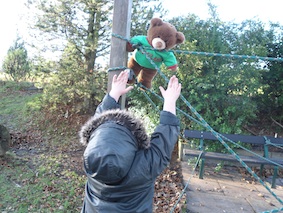This has been a ropey session since August. There is something about rope that just makes it fun and appealing to children of all ages. The more I use it, the more I learn about its potential, particularly for group and cooperative work.
The boys in the photo below are experimenting with rope…

They started out making dens. Thanks to the use of rope, these can become quite complex structures…

I’m into the easy life. Even in Sweden, I liked the comfy side of rope work…

Many children simply like unravelling rope and making snake-like pattern movements with it. Others will just go for a walk with a rope…

Children quickly learn to make and use simple swings…

…and more complex ones. It took two sessions before the children had learned to chuck the rope over the high branch accurately…

Rope bridges require a lot of trial and error when creating as it’s easy to make the rope too slack…

And talking of slack, even the teachers enjoy a chance to walk on a slack line…

Fastening a rope to a tree is good for winding and binding…

But somehow Fred the Ted got bound up too! He hadn’t even been naughty so I think he just wanted to be rescued…

I’ve discovered that one class rather like holding the rope in a line. When we get to the top of the hill, making a circle with the rope is easier than without!

Older and younger children enjoy an impromptu game of Tug o’ War…

Fred the Ted really likes getting caught up in the rope! Here he is again! He climbed up and then got stuck! Fancy that!

Finally rope webs can be a simple or challenging activity depending on the ability of any child. For this girl, simply managing to step through the web from one side to another was an absorbing challenge.

I’ve blogged previously about ropes and sensory trails made of ropes. Enjoy browsing! Oh and tell me about the adventures your children have with ropes… there’s many more to come right here.




















Well, we did pay homage to our Mulberry tree in one of our blog posts with particular emphasis on its rope donning ability : )
http://beansproutspreschool.blogspot.com/2011/05/rope-tree_19.html
I still get this weird paranoia about children choking from ropes but the more I read about rope play (and the more I see how badly the children want to use ropes), the more willing I am to allow them to do so. I guess wrapping around the body can be one of the safety restrictions.
Thanks for the thought-provoking post.
Hi!
Everyone should visit the Beansprouts Preschool blog post – it’s super.
I don’t think your paranoia is weird – it’s about having a healthy respect for rope.
We always supervise rope play and remove the ropes at the end of each session. The rule I have is no ropes around necks (obviously) and also I request that hands and arms are not tied up – simply to avoid a child running, tripping and not being able to catch themselves.
However using bright ropes actually helps children develop a spatial awareness as they learn to look out for themselves and others around the rope.
There’s a handy guide on the London Play website about tree swings which is worth downloading http://www.londonplay.org.uk/file/1542.pdf
Great Job! I manage a Nature Center and have a preschool called Little Sprouts Early Learning Center. We also have an after-school program called Kids n Nature Adventure where 150 kids come out weekly. Visit us on facebook. Pilcher Park , Pilcher Park Nature Center AND my blog http://www.playinnature.com
Hi Debbie
Thanks for leaving information about your nature center and preschool – it all sounds really interesting. I’ve already checked out your Facebook page.
I really appreciate anyone telling me about their blog, website or organisation that’s about getting children outside. Together we are all stronger!
Best wishes
Juliet
Thanks Juliet for bringing up ropes again. They disappeared from my radar. I have made a mental note to try them—inside—either in my large muscle area or around the sensory table. They should work inside , too, right? Tom
Hi Tom
I think ropes would work fine inside too. A couple of things spring to mind
– Ropes up high for pulley systems (this will really dovetail with your trays and transporting pellets etc)
– Perhaps keep the ropes shorter. Outside I’m less fussed about length but in the confines of a classroom it might help
– Use a variety of ropes. Every material has a value because of their different thicknesses and properties. I actively seek different types of rope for the impact on the experience.
– Remember ropes work well as part of any big weaving project, e.g. through nets
– Washing lines are a form of rope work too.
Wow, lots of great ideas. Thanks.
relay good pictures and it helped my dad allot with the froset school that he dose
it means he can make a slide show with the pictures of this website
Our nursery school is currently involved in a legal battle with our state Office of Early Childhood. They insist any rope is a danger for preschool-age children no matter what the circumstances or level of supervision. They refused our offer of having a rope swing only on special occasions outside our fenced playground with one-on-one supervision and a parent permission slip. They have filed charges against our program for refusing to back down. We have an administrative hearing scheduled. Next step superior court. *sigh*
I wish you all the best – this is not an easy situation.
Hi, I have recently started my forest school leader training and have become obsessed with ropes!! They are so much fun and can be so many things! Our pre schoolers favourite is a rope from the tree with a slip knot in the bottom for feet to go in. Can you tell me the best knot to anchor the rope to the tree with please? Thank you 😊
Hi Sarah
It all depends on the type of tree swing you are considering and whether it is a temporary or permanent feature. My swings tend to be temporary affairs so I need quick release knots and swings which mean I can take down the swing in a short space of time. It may be worth asking this question on a Forest School Discussion group page on Facebook.